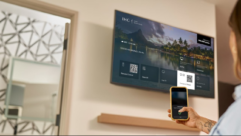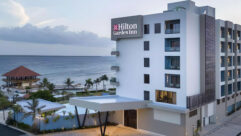Making Yourself At Home: Designing and installing for hotels and lodgingfacilities calls for attention to specific details.
Jan 1, 1998 12:00 PM,
Jeff Loether
Quality in any technology is a moving target. The experienced designerlooks back to see where we’ve been, anticipates the direction of change,looks ahead and plots a course to reach the future. Over the course of morethan 17 years of observation and participation in the development ofpresentation technologies in the lodging and hospitality industry, Idiscovered that with careful listening, thinking and planning, systemdesigner-installers can discover the meaning of quality for each of thevarious “stakeholders” in the facilities for whom they work.
Influences and trendsWhat internal and external influences have been pushing or pulling changesin hotel A-V systems during the past decade? In what direction are weheading?
Advancing visual technologiesAs presentation and entertainment technologies advance, the video part ofA-V becomes more important to systems design. However, as many facilitydevelopers and operators need to accommodate a wide range of meetingconfigurations, their ideal facility design must be very flexible. Thearchitectural concept of flexible function space is still popular wherelarger spaces are sub-divided with operable partitions accommodatingmultiple podium, lectern and head table positions. The “building-in” ofvideo or visual elements in these facilities is not always practical, andoften you will find that providing interconnecting cabling and projectionscreens is all that will be necessary.
Another significant trend involves the increasing use by presenters andtrainers of multimedia, computerized and interactive A-V presentationmaterials. Laptops with sound cards are the norm. Slide projectors aregathering dust while LCD panels for overheads and LCD and CRT projectorsare in constant use.
And, as with most everything else, the development of the microprocessorhas had a significant impact on the technical capabilities of A-Vequipment. Digitally controlled analog and completely digital processingequipment are becoming more common. Control systems and components arebecoming much more flexible and much less expensive.
Rising expectancyRising guest expectations of quality result from the proliferation ofhigh-quality programming and production as well as improvements in mediafor program delivery, such as CDs and digital satellite television. Today’sguests and meeting planners are much more savvy and sensitive to thequality of the audiovisual experience; older technology and outdatedequipment are not as easily accepted. When they come to a hotel orconference center, guests and meeting planners expect A-V equipment andsystems at least as good as in their homes or offices.
This rising expectancy, combined with the increasing complexity ofpresentation technologies, has led many facilities to create dedicated A-Vservices departments rather than handle this function through the catering,banquet or engineering departments. In many cases, A-V services areprovided by outside rental companies who set up in-house operations and paythe hotel management a commission on the A-V rentals. Other properties,especially the high-end hotels and conference centers, are bringing themanagement of A-V operations in-house by hiring talented technicians andbuying their own A-V equipment. In both cases, the meeting planner andguest have a more knowledgeable A-V representative to assist in theirmeeting arrangements.
Economic trendsTwo global economic factors that have affected hotel A-V systems are thesaturation of the hotel market in the late 1980s in most major metropolitanareas and the recession of the early 1990s. Compared to the boom of the1980s, fewer new hotels were and are being built. However, the hotelindustry is currently enjoying a strong recovery, so we are seeing morehotel renovating than ever before. The higher-end hotels are increasinglycompetitive and preparing for the accelerated advancement in presentationtechnologies. We see an embracing of technology where there was somereluctance in the past. The mid-range properties are updating and improvingtheir A-V systems as well.
DistinctionThe increased development of conference centers reflects a willingness ofmore developers and operators to specialize in and capture “niche” marketsin the meeting industry. Featuring specialized architecturalaccommodations, high-quality, high-technology audiovisual systems and ahigh degree of personal service with in-house meeting planning and A-Vdepartments, these facilities are attractive to the higher-end, smallergroup meeting clientele.
Features and functionsAll of these influences have been moving the hotel and conference centerA-V systems toward tomorrow. Let’s take a look at the basic functions thatmeeting facility A-V systems are expected to provide.
Microphone useThe primary use of the hotel house sound system is to provide voicereinforcement from one or two microphones. This simple requirementrepresents the lion’s share of the house sound system’s service. However,as guests’ expectations for quality sound increase, their tolerance ofbackground noise, narrow frequency response, limited dynamic range andintermittencies is lower; they expect better quality.
As the reliability and quality of wireless microphone technologies improve,the use of wireless microphones is increasing. The movement from overheadprojectors and flip charts to computer-based presentations with laserpointers and wireless microphones makes presenters much more mobile thanthey ever were. Tone-encoded squelch, more UHF options, longer batterylife, better capsules and lower costs all combine to accommodate theincreasing desire for these presentation tools.
Although the majority of events only require one or two microphones, we seean increasing number of meetings that require many more. Recording of themeetings, audio and video teleconferencing, audience participation andpanel discussions all require multiple microphones. However, where thebuilt-in hotel sound systems once were expected to accommodate most or allmicrophones, these applications are now being handled more frequently within-room portable microphone mixers, from simple four-input tofull-production consoles complete with standing technician.
Regarding the use of automatic mixers, as the cost goes down andavailability of quality portable automatic mixers increases, we see moreuse of these as portables in the function rooms rather than in theequipment racks. This provides the benefit of automatic microphone mixingwithout the cost associated with providing dedicated automatic mixers forevery room or salon. The advantages of in-room automatic microphone mixersinclude more gain, less feedback, in-room balancing controls and theability to provide many more microphones in a room than with manual mixers,even with an operating technician. All result in enhanced systemperformance and greater guest satisfaction.
Another trend for accommodating many microphones involves the use ofportable or built-in “delegate” systems. These place small consolettesequipped with a stalk-type microphone, speaker and “press-to-request” or”press-to-talk” switch in front of each participant. A computerized controlsystem manages the number of open microphones and signals participants witha “talk” light when it is their turn. These systems may be integrated withautomated video camera control or computerized voting systems as well.
A-V program reinforcementPresentations increasingly include one or more multimedia elements, such asvideotape, laserdisc or soundtrack embedded in computer-based presentationpackages. Voice-only sound systems will not be satisfactory for theseapplications because of the enhanced frequency range of the program contentand production. Because of this requirement, coupled with the need tocorrelate the apparent visual and audio point of origination of thepresentation, portable speakers are frequently used for these applications.Larger meetings may use the house sound systems with multiple zones ofsignal delays to supplement the portable systems. Often, the overheadceiling speakers are used simultaneously for real-time voice reinforcementand delayed program reproduction.
Background musicUntil about 10 years ago, the only methods of providing background music ina hotel were using private broadcast (subcarrier), leased phone lines oron-premises tapes. Now, with the proliferation of digital satellitebroadcast distribution, the variety and availability of music programminghas increased dramatically.
Competition among programmers has also increased, making it a buyer’smarket for these services. Instead of settling for just a few differentmusic formats to accommodate events, hotels now may select from among 60unique digitally delivered channels of commercial-free music to accommodateany event. Control systems are now available to permit choosing the musicselection from within the function space itself, and most sound systemsinclude a multi-disc CD player to permit accommodating special events.
RecordingThe recording of meetings is becoming much more prevalent in both hotelsand conference centers. This trend is partially a result of the movementtoward hotels having in-house A-V expertise, offering more services, andtoward increased expectancy by meeting planners. Evidence of this trend isthe increase in the number of independent conference audio and videorecording companies.
Full-production eventsFew hotels and conference centers are equipped with built-in systemscapable of accommodating a full-production event. By full-production, I amreferring to multiple screen image magnification using projection orvideowalls, pre-recorded video and computer-based programming, andmultiple, simultaneous presenters and performers. These productionstypically include theatrical lighting, elaborate staging and sometimesspecial effects, such as fog, lasers or pyrotechnics. These dramatic showsare used for product unveilings, motivation, conventions and increasinglyfor high-impact training.
The high level of sophistication of the systems and equipment (not tomention the cost) and unique configuration of the rooms make built-insystems practical only for those facilities that have an auditorium ortheater as part of their complement of function spaces. Most hotels andconference centers are not so equipped because the concept of flexiblefunction spaces precludes such fixed features. Renting portable sound,light and video systems and temporarily installing them into the hotelfacility typically accommodates these full-production events. The A-Vdepartments in larger facilities may own all of this equipment for suchevents.
If properly designed, the built-in systems can be used to complement andsupplement the use of portable sound equipment. Signal delays, processorsand other effects devices may be inserted into the feed to the house systemto improve the impact of the production significantly while reducing theoverall amount of portable equipment necessary.
InfrastructureYou will currently find much more hotel A-V renovation work than newconstruction. One area that becomes significant and, unfortunately, isfrequently overlooked during renovations is the facility’s infrastructure:the conduit, cabling, power, grounding and physical accommodations for thebuilt-in A-V systems.
As facilities age, connections deteriorate, and changes must be made to thepower mains to accommodate new equipment and systems elsewhere in thebuilding. Any renovation work should include restoring (or creating) cleanpower and ground service to the A-V systems. This requirement is especiallycritical because new equipment increasingly includes microprocessors aswell as guest and presenter source devices.
Also, aging HVAC systems tend to make more noise as bearings wear,vibration isolators compress, and systems settle and vibrate connectionsloose. HVAC noise increases the level of background noise, makingintelligible reinforcement more difficult.
ADA requirementsAny renovation or new construction project today must consider therequirements of the Americans with DisabilitiesAct. The most significantimpact we see is locating A-V controls and input plates in function spacesat a height that is accessible to persons in wheelchairs. Otherrequirements include visual paging and assisted listening systems for thehearing impaired. Because the implementation of the ADA is still evolving,many additional interpretations of this legislation will affect the waymedia installs will be done in the future.
Perspectives of qualitySo what is quality? It is said that perception is reality. Whoseperception? Many individuals contribute to the process of any renovation ornewly constructed facility; all of these people have a stake in and anopinion on the quality and implementation of the audio and video systems,whether they are for presentation or reinforcement. Let’s step aside fromour traditional roles and look through the eyes of our clients tounderstand how they look at our designs and installations. Let’s ask them,”What does quality mean from your perspective?”
The owner”In the overall project, the A-V systems are really a small part; a smallbut important part. I want to know that we’re using good quality,commercial-grade products that are appropriate to meet our needs. We’re notbuilding a Taj Mahal here, so don’t load the system up with lots of gadgetsthat my operator won’t use. A quality A-V system is a value-engineered,cost-effective system that meets our basic needs today and tomorrow.”
Architect”I don’t want to see it! The A-V system components and controls should bebuilt into the interior milllwork and the speakers should not be visible.But it should sound great. I want the guests’ experience to result from acoherent blend between what they see and what they hear. A quality A-Vsystem appears out of nowhere when you need it and disappears just aseasily when you don’t. A quality A-V system is an invisible,high-performance work of art.”
Engineering department”The systems should be easy to troubleshoot, repair and maintain. I wantthe A-V department to be able to identify and resolve any problem quicklywithout having to dismantle the system in the process or even open the backof the equipment racks. We must be able to repair or replace the defectivecomponent without taking the whole system off-line. A thoughtfullydesigned, properly installed, well-documented system with operations andmaintenance manuals makes this a lot easier. A quality A-V system doesn’tdepend on any single component that can take the whole system down.”
Sales department”The A-V system must be able to accommodate all of our needs, from thesimple background music for receptions to full, multimedia productions andvideo teleconferencing. We want our property to look and sound state of theart compared to any other property in our market. A quality A-V system istotally flexible and offers high performance.”
A-V department”Above all, the system must be reliable. I’d rather have a basic,consistent, reliable A-V system than a super high-performance system thatis intermittent. Important information is being communicated in thesemeetings, and we can’t afford a breakdown or inconsistent performance. Ifthe system is finicky, I have to install a backup system as insurance,which requires twice as much equipment and clutters the meeting room (and Ican’t charge double the rent).
“Also, the system must be easy to use. The meeting planners in the salesdepartment often set up back-to-back meetings that involve quick turns ofthe room, so the system must easy to set up and change. Normalledpatchbays, controller/combiner systems and convenient input plates andequipment rooms all make my job easier. A quality A-V system is above allreliable and easy to operate.”
Five tenets of qualitySo, what have we learned? The following five areas comprise what ourclients require of a quality system design:
Reliability: The most important of all issues. Anything less thanconsistent, reliable service is courting a tarnished reputation for thesystem and property. As with integrity, it’s either reliable or it’s not.Very little gray area here.
Flexibility: The architecture of flexible function spaces in hotelsrequires the technical systems to follow suit. Room combiners, patchbaysand carefully placed A-V input and control plates permit readyaccommodation of the meeting planners’ wildest dreams.
Ease of use: Logical, intuitive controls for the system and equipmentpermit quick setup and changes of the systems by all levels of staff.
Performance: As perception and expectancy increases in our clients andtheir clients, A-V and multimedia system performance continues to grow asan important factor. The performance minimums of yesterday are sub-standardtoday. The bar is being raised on legibility, intelligibility, dynamicrange and signal-to-noise ratio. Our audience is learning to hear and seebetter than before.
Cost-effectiveness: Each system component must be evaluated using thesequality criteria for cost and benefit. Does it enhance reliability?Flexibility? Ease of use? Performance? If it doesn’t, why is it in thesystem? Design it as though you were spending your own money.
The futureLet’s take a look in the crystal ball and imagine where the trends we areexperiencing today will take us, and how to prepare for that trip. Many ofthese vistas are appearing right now.
Architechnology: This term has been used for many years to describe theintuitive and seamless integration of multimedia presentation andentertainment technologies into the surroundings and building elements.Often, A-V components are wheeled in and hung there; the meeting spaces ofthe future will be more elegant and visually integrated. Flat paneldisplays will become part of the interior design elements. We’ll seewireless interactive touchscreen control systems that provide instantaccess and control of all room environmental elements, from lights to musicto temperature. Wireless, secure Internet and telecommunicationsconnectivity will be available to guests throughout the property.
Infrastructure: As recently as 10 years ago, the worlds of computers,telephones, audio and video were independent technologies. The distinctionsthat once defined the boundaries among these technologies are blurring withthe proliferation of digital audio and video, computerized control systems,wireless technologies and the Internet. This trend will continue ascomponents and systems become more dependent on digital processing andintercommunication.
This blurring of distinctions within the technologies themselves impactsthe building infrastructure required to support these systems. Today’stechnologies include digital control of analog functions, so signals arestill communicated using conventional cabling and infrastructure.Tomorrow’s A-V and multimedia technologies include full digitalcommunication among various technologies along both copper and fiberbackbones. Careful preparation during today’s renovation and newconstruction projects will make accommodating tomorrow’s technologies mucheasier. More than ever, the quality of the power and grounding for thesesystems will be critical to reliable operation.
The market: We will see an increase in the phenomenon of risingexpectations as technology becomes more of a servant to our inclinations inour personal and business worlds. Advances and proliferation of homeautomation and microprocessor control systems will precipitate a “Why not?”response when meeting planners and guests learn that their hotel guest roomor meeting room doesn’t have an automatic this or an accessible that. Whatimpresses meeting planners and guests today will be expected tomorrow. Theacceleration of expectations is increasing at “net speed.”
The Internet: Speaking of the Internet, imagine what an “Internet ready”intelligent meeting room A-V system will be like. We’ll see virtual audioand video conferencing between distant properties with perfect clarity andintelligibility. Other common features will include real-time monitoringand automatic adjustment of all system parameters and functions; wirelesssystem control panels that use browser-like interfaces to access all systemfunctions; and communication across systems and platforms with real-timecollaboration among participants around the world. Every function space andguest room will have high-speed Internet connectivity and presence.
So, where lies the opportunity? It is in looking ahead, staying flexible,listening to our clients and preparing for the future. It has been saidthat the best way to predict the future is to create it. Perhaps we as anindustry can create a exciting future by reflecting the qualities asconsultants and contractors that we design into our A-V systems:reliability, flexibility, ease of use, high performance andcost-effectiveness. Future opportunity lies in meeting and exceeding ourclient’s expectations.










